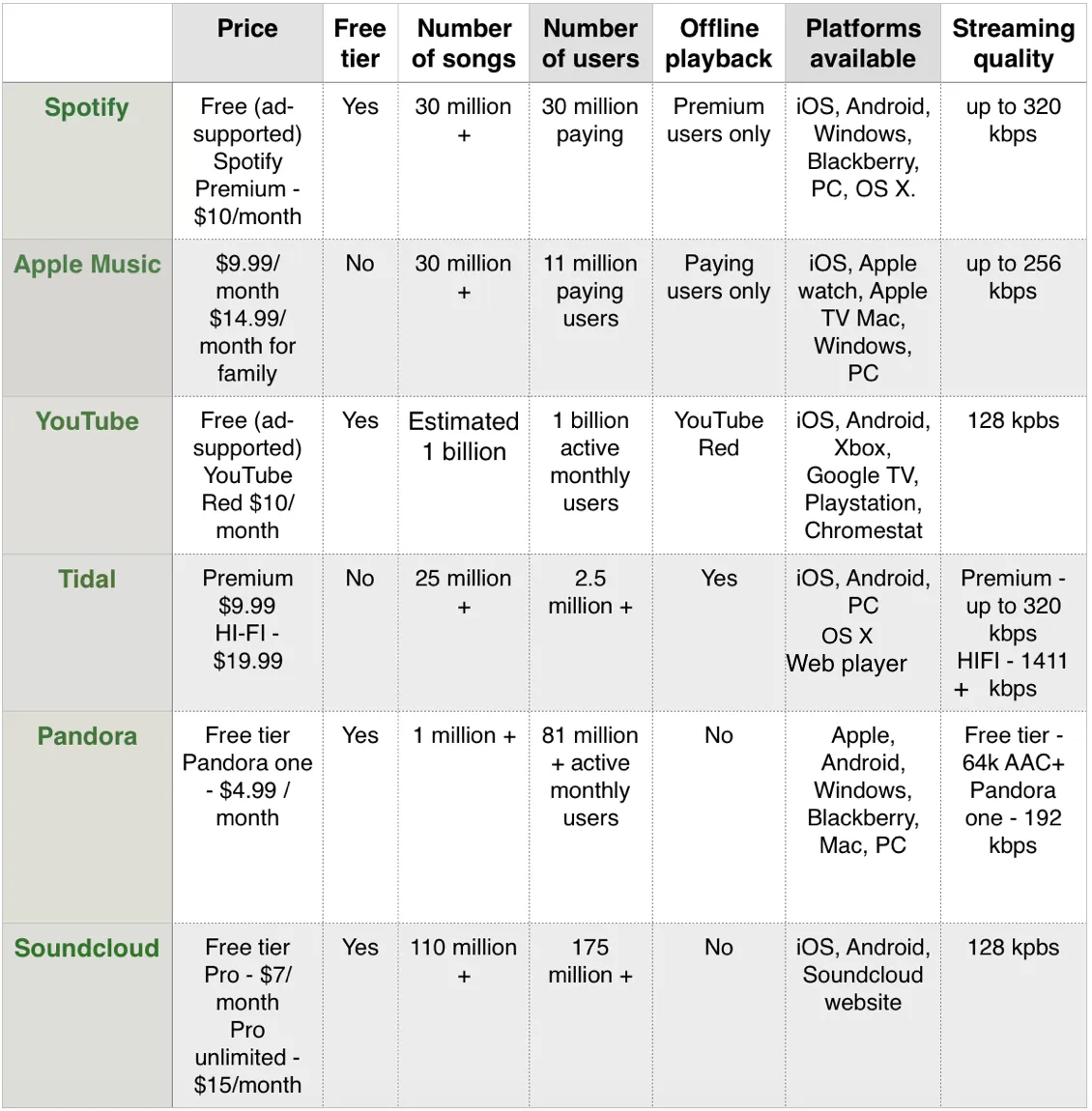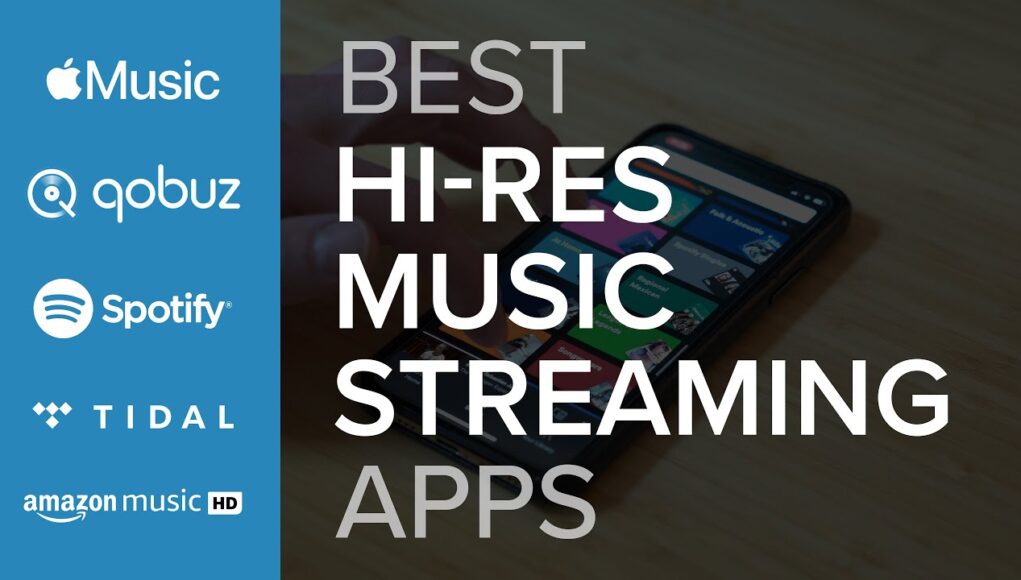Ultimate Showdown: 5 Top Music Streaming Apps Compared
Related Articles: Ultimate Showdown: 5 Top Music Streaming Apps Compared
- 5 Amazing Note-Taking Apps To Supercharge Your Productivity
- Amazing 5 Budgeting Apps To Master Your Finances
- Essential 7 Travel Apps For Seamless Adventures
- Essential Project Management Software: 5 Game-Changing Tools For Teams
- Essential 7 Video Editing Tools Every Filmmaker Must Master
Introduction
With enthusiasm, let’s navigate through the intriguing topic related to Ultimate Showdown: 5 Top Music Streaming Apps Compared. Let’s weave interesting information and offer fresh perspectives to the readers.
Table of Content
Ultimate Showdown: 5 Top Music Streaming Apps Compared

Choosing the right music streaming app can feel overwhelming. With so many options vying for your attention, each boasting unique features and pricing, finding the perfect fit requires careful consideration. This in-depth comparison analyzes five leading contenders – Spotify, Apple Music, YouTube Music, Amazon Music Unlimited, and Tidal – across key criteria to help you make an informed decision. We’ll delve into sound quality, library size, social features, offline capabilities, and pricing, ultimately empowering you to select the platform that best aligns with your musical needs and budget.
1. Spotify: The Global Giant
Spotify’s dominance in the music streaming market is undeniable. Its vast library, boasting over 80 million tracks, caters to virtually every musical taste. The platform’s algorithm-driven recommendation engine, “Discover Weekly,” is lauded for its ability to introduce listeners to new artists and genres, constantly expanding their musical horizons.
-
Sound Quality: Spotify offers a range of sound quality options, from basic compressed audio to higher-fidelity "High Quality" streaming (320 kbps). While not quite audiophile-grade, it’s perfectly acceptable for most listeners. The absence of lossless audio is a notable drawback for audiophiles.
-
Library Size: As mentioned, Spotify boasts an extensive library, covering a wide spectrum of genres and artists. Its comprehensive catalog is a major selling point, making it unlikely you’ll find yourself wanting for your favorite tunes.
-
Social Features: Spotify offers robust social features, allowing users to share their playlists, follow friends, and see what music their network is listening to. The ability to collaboratively create and edit playlists adds a social dimension to the listening experience.

Offline Playback: Spotify allows users to download tracks for offline listening, a crucial feature for those with limited or unreliable internet access. The downloaded tracks are conveniently accessible even without an internet connection.
-
Pricing: Spotify offers a free, ad-supported tier, alongside premium subscription options offering ad-free listening, higher-quality audio, and offline playback. Its pricing is generally competitive, making it an accessible option for various budgets.
-
Unique Features: Spotify’s podcast integration is a significant advantage, seamlessly blending music and spoken-word content within a single platform. Its personalized playlists and collaborative features further enhance its appeal.
2. Apple Music: A Seamless Ecosystem
Apple Music, deeply integrated into the Apple ecosystem, offers a compelling alternative for iPhone, iPad, and Mac users. Its strengths lie in its user-friendly interface, tight integration with other Apple services, and high-quality audio options.

Sound Quality: Apple Music provides high-quality streaming at 256 kbps, along with a lossless audio tier (ALAC) for subscribers seeking superior sound fidelity. This makes it a strong contender for audiophiles who value pristine audio reproduction.
-
Library Size: While not quite as extensive as Spotify’s catalog, Apple Music boasts a massive library, covering most popular artists and genres. The library’s comprehensiveness is unlikely to disappoint the average listener.
-
Social Features: Apple Music’s social features are less prominent than Spotify’s, but it allows users to share playlists and follow friends. The social aspect is less emphasized, focusing more on individual listening experiences.
-
Offline Playback: Similar to Spotify, Apple Music allows users to download tracks for offline listening, ensuring uninterrupted playback even without an internet connection.
-
Pricing: Apple Music’s pricing is comparable to Spotify’s, offering a competitive monthly subscription fee. Its family plan offers significant value for families sharing a single account.
-
Unique Features: Apple Music’s integration with Siri, Apple’s voice assistant, is a significant advantage. Users can easily control playback, search for music, and create playlists using voice commands. Its curated playlists, often featuring exclusive content, are another key differentiator.
3. YouTube Music: The Video-Centric Option
YouTube Music, leveraging YouTube’s vast video library, offers a unique blend of music streaming and video content. While its core functionality is similar to other platforms, its video integration sets it apart.
-
Sound Quality: YouTube Music offers a range of sound quality options, though the highest quality may not match the best offerings from Spotify or Apple Music.
-
Library Size: YouTube Music boasts a colossal library, benefiting from YouTube’s immense video catalog. This includes official music videos, live performances, and user-uploaded content, providing an unparalleled breadth of musical material.
-
Social Features: YouTube Music’s social features are relatively limited compared to Spotify. Sharing playlists and following artists is possible, but the social aspect is less emphasized.
-
Offline Playback: YouTube Music allows offline downloads, enabling uninterrupted listening even without an internet connection.
-
Pricing: YouTube Music offers a free, ad-supported tier, alongside a premium subscription that removes ads and unlocks offline playback and background listening. Its pricing is generally competitive.
-
Unique Features: YouTube Music’s integration with YouTube’s vast video library is its unique selling proposition. The ability to seamlessly switch between audio and video content is a significant advantage for users who enjoy watching music videos.
4. Amazon Music Unlimited: For Prime Members
Amazon Music Unlimited is tightly integrated with Amazon’s ecosystem, offering attractive pricing for Prime subscribers. Its library is vast, and its integration with Alexa makes it a convenient option for smart home users.
-
Sound Quality: Amazon Music Unlimited offers high-definition audio (HD) and Ultra HD audio options for its premium subscribers, catering to audiophiles who value superior sound quality.
-
Library Size: Amazon Music Unlimited boasts a substantial library, covering a broad range of artists and genres. Its catalog is comprehensive enough to satisfy most music listeners.
-
Social Features: Amazon Music Unlimited’s social features are relatively basic, lacking the depth and richness of Spotify’s social functionality.
-
Offline Playback: Offline downloads are supported, enabling users to enjoy their music even without an internet connection.
-
Pricing: The pricing is particularly attractive for Amazon Prime members, offering a discounted subscription compared to non-Prime users. This makes it a cost-effective choice for those already subscribed to Amazon Prime.
-
Unique Features: Amazon Music Unlimited’s seamless integration with Alexa, Amazon’s voice assistant, is a key differentiator. Users can control playback, search for music, and create playlists using voice commands.
5. Tidal: The High-Fidelity Champion
Tidal distinguishes itself by prioritizing high-fidelity audio, offering lossless audio streaming (Master Quality Authenticated – MQA) to its subscribers. This makes it the preferred choice for audiophiles who demand the highest possible sound quality.
-
Sound Quality: Tidal’s commitment to high-fidelity audio is its defining characteristic. Its MQA-encoded tracks offer superior audio quality compared to most competitors.
-
Library Size: While Tidal’s library is smaller than some competitors, it still boasts a considerable selection of music, encompassing a wide variety of genres and artists.
-
Social Features: Tidal’s social features are relatively basic, focusing more on individual listening experiences rather than social interaction.
-
Offline Playback: Offline downloads are available, allowing users to enjoy their music even when offline.
-
Pricing: Tidal’s pricing is generally higher than its competitors, reflecting its commitment to high-fidelity audio. This makes it a premium offering aimed at audiophiles.
-
Unique Features: Tidal’s focus on high-fidelity audio and its curated editorial content, featuring interviews and behind-the-scenes content, sets it apart from the competition. Its commitment to artist compensation is also a distinguishing factor.
Conclusion:
Choosing the best music streaming app depends heavily on individual priorities. Spotify’s vast library and social features make it a popular choice, while Apple Music’s seamless integration into the Apple ecosystem is a significant advantage for Apple users. YouTube Music offers a unique video-centric experience, Amazon Music Unlimited provides attractive pricing for Prime members, and Tidal caters to audiophiles with its high-fidelity audio. By carefully considering your needs and budget, you can select the platform that best suits your musical preferences and listening habits. This comprehensive comparison should empower you to make an informed decision and embark on a richer, more enjoyable musical journey.
Closure
Thus, we hope this article has provided valuable insights into Ultimate Showdown: 5 Top Music Streaming Apps Compared. We appreciate your attention to our article. See you in our next article!
google.com








